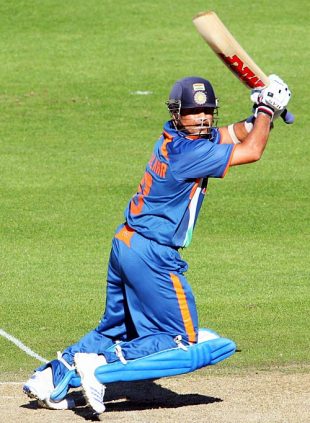|
|
|

Sachin Tendulkar was in imperious form, hitting five sixes and 16 fours in his 133-ball innings, his first ODI ton in New Zealand
© Getty Images
|
|
| |
It generally comes with a stroll of a single to a safe area, say long-on or deep fine-leg. By the time
Sachin Tendulkar reaches the non-striker's end, the crowd goes delirious. The helmet comes off, the head tilts up skywards, the back arches a little, the head comes down and looks at the crowd and team-mates in acknowledgment, the fists are pumped, bat in one hand and helmet in the other, and then the head tilts up again. And lo, Tendulkar has reached another hundred. His is a smooth, well-oiled, economical, calculated celebration. The same can easily be said of his centuries. Not the ones Tendulkar the wunderkind used to score, but the ones the master assessor does.
The slowed instincts, the fragile body be damned. Tendulkar has played so much cricket his experience makes up for it. In the lead-up to the third ODI New Zealand had focused all their strategies on, even confessed to fearing, Virender Sehwag. They managed to dislodge Sehwag early today, but the way he plays, he's likely to give the bowlers chances.
Tendulkar isn't likely to do that. You'd assume that a player who scores 163 in a 50-over game has to keep the bowling side interested, with audacious shots, with risks taken throughout the knock. Tendulkar didn't, and kept the bowlers ruthlessly out of the game. "I don't remember even one shot that didn't come off the middle of the bat," was Brendon McCullum's assessment later. Tendulkar didn't leave people agape, he involved them in the ride.
So just how did Tendulkar set himself into a position to aim at the first ODI double-century before he had to retire hurt after 45 overs? Well, he shifted gears seamlessly, not letting the bowlers get an inkling of what was coming next. The innovations met the orthodox in a perfect cocktail. The straight hits, the dabs, the paddle sweeps, all hurt New Zealand. There was nothing, after close to 20 years of batting, that the bowling side wouldn't have been prepared for. But all through the day, New Zealand were one step behind Tendulkar.
He gauged the pitch, the conditions, the dimensions of the ground perfectly, and paced his innings accordingly. Having got accustomed to Sehwag's blazing starts on this tour, it even seemed Tendulkar was unobtrusive to begin with. The ball was skidding a bit off the surface, and Tendulkar was taking his time.
But look at what he did at crucial junctures in the game. After Sehwag got out, Tendulkar pulled the plug out of New Zealand's confidence with a counterattack in the next few overs. The square cut off Tim Southee in the over after Sehwag's dismissal, between point and cover, who were close to each other, will stay with the bowler for a long time. Three boundaries came in the next three overs, and Tendulkar went back to accumulation mode again.
Soon after Gautam Gambhir's dismissal came the most critical moment of the match, which had a fair share of such moments until the end. The match was going back to type when New Zealand introduced Jeetan Patel in the 21st over. A period of consolidation looked in the offing, which would be followed by a batting Powerplay somewhere close to the 40th over. But Tendulkar looked at it another way. He wanted to make Patel bowl as late in the innings as possible. Yuvraj Singh had hit a sweetly-timed boundary off the first ball he faced, and India had enough confidence to go for the batting Powerplay. McCullum, the New Zealand captain, and the chosen medium-pacers to do the job then, were both caught by surprise. Not only was Daniel Vettori the captain missing, perhaps more importantly Vettori the crafty, miserly bowler was absent.
And so with the batting Powerplay came another shift of gear. Not for a moment during that span did it appear the bowlers would have wished to bowl more to Tendulkar, as opposed to Yuvraj. Three fours and a six came for Tendulkar in the Powerplays, none better than the paddle-sweep off Southee which comfortably went for six. Tendulkar was 82 off 78 balls then, and post Yuvraj's dismissal he didn't let the momentum die, getting into the nineties with a six.
The most destructive phase of the innings came after the century, by which time the pain in his abs, where he was hit in the last game, was starting to reach unbearable proportions. Back came Patel, whose reintroduction Tendulkar had delayed into the latter overs, and the batsman hit him over long-off and steered a quick full toss to third man. The big hits kept coming after that, the 200 kept coming closer to sight with every over. Tendulkar needed just 32 deliveries to move from 100 to 163.
After the match, Tendulkar said he didn't reckon any target could be safe with these short boundaries. That proved to be a correct assessment. Tendulkar kept on pushing until he could push himself no more. Close to 100 of his runs came with pain in his abs, after he had "twitched" it when around 70. He may not have astonished while you saw the innings - and that's a credit to him because he has shown it all - but in the light of how bad his injury was, those sixes sound more and more amazing.
New Zealand is the place where we first saw Tendulkar open the innings, as a raw, crazy diamond. Today the fans lapped up a calculating genius at play, which was just as satisfying.
Sidharth Monga is a staff writer at Cricinfo

